coolant level Hyundai Equus 2016 Owner's Manual
[x] Cancel search | Manufacturer: HYUNDAI, Model Year: 2016, Model line: Equus, Model: Hyundai Equus 2016Pages: 477, PDF Size: 16.25 MB
Page 19 of 477
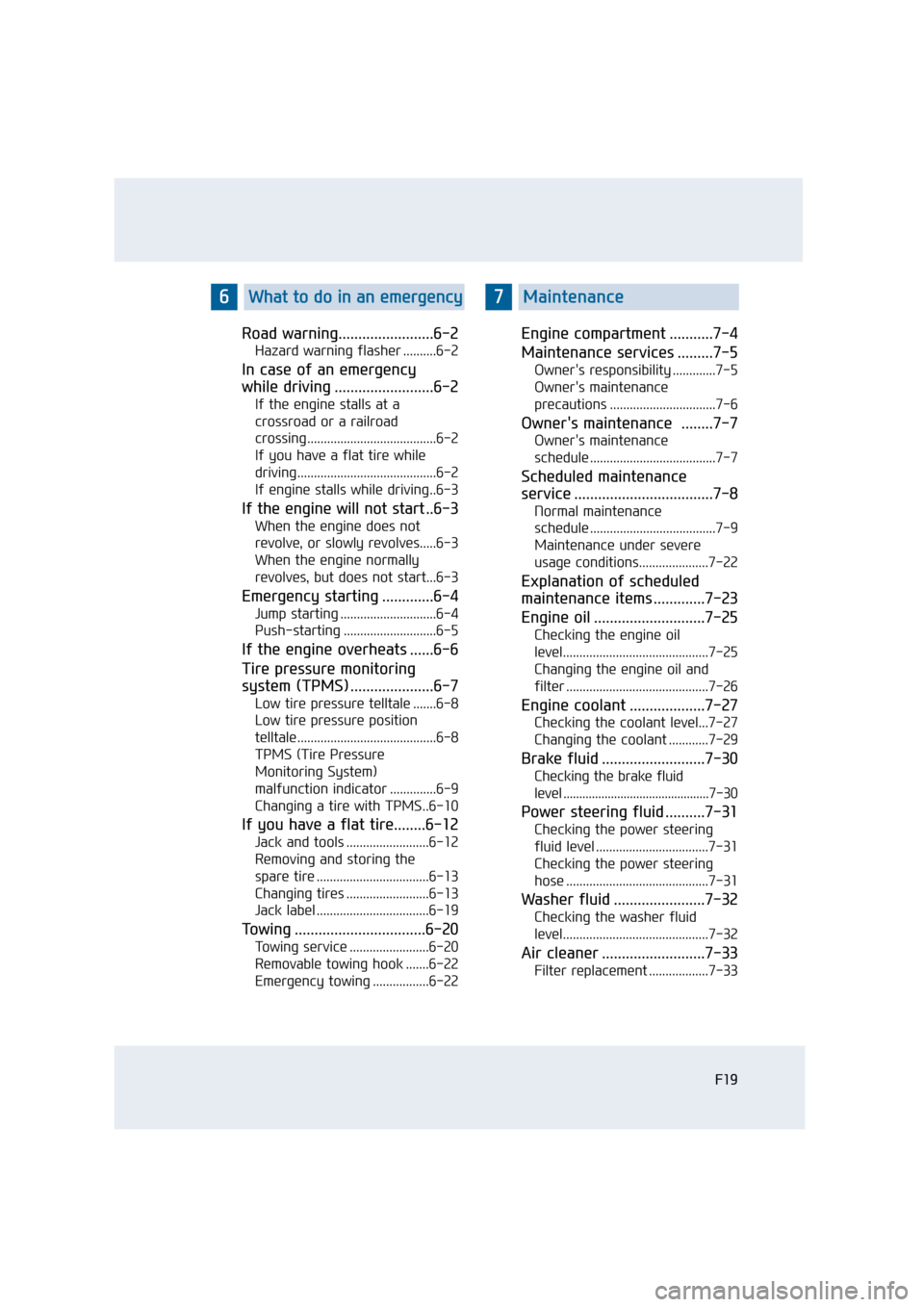
Road warning........................6-2
Hazard warning flasher ..........6-2
In case of an emergency
while driving .........................6-2
If the engine stalls at a
crossroad or a railroad
crossing.......................................6-2
If you have a flat tire while
driving..........................................6-2
If engine stalls while driving..6-3
If the engine will not start ..6-3
When the engine does not
revolve, or slowly revolves.....6-3
When the engine normally
revolves, but does not start...6-3
Emergency starting .............6-4
Jump starting .............................6-4
Push-starting ............................6-5
If the engine overheats ......6-6
Tire pressure monitoring
system (TPMS) .....................6-7
Low tire pressure telltale .......6-8
Low tire pressure position
telltale..........................................6-8
TPMS (Tire Pressure
Monitoring System)
malfunction indicator ..............6-9
Changing a tire with TPMS..6-10
If you have a flat tire........6-12
Jack and tools .........................6-12
Removing and storing the
spare tire ..................................6-13
Changing tires .........................6-13
Jack label ..................................6-19
Towing .................................6-20
Towing service ........................6-20
Removable towing hook .......6-22
Emergency towing .................6-22
Engine compartment ...........7-4
Maintenance services .........7-5
Owner's responsibility .............7-5
Owner's maintenance
precautions ................................7-6
Owner's maintenance ........7-7
Owner's maintenance
schedule ......................................7-7
Scheduled maintenance
service ...................................7-8
Normal maintenance
schedule ......................................7-9
Maintenance under severe
usage conditions.....................7-22
Explanation of scheduled
maintenance items .............7-23
Engine oil ............................7-25
Checking the engine oil
level............................................7-25
Changing the engine oil and
filter ...........................................7-26
Engine coolant ...................7-27
Checking the coolant level...7-27
Changing the coolant ............7-29
Brake fluid ..........................7-30
Checking the brake fluid
level ..............................................7-30
Power steering fluid ..........7-31
Checking the power steering
fluid level ..................................7-31
Checking the power steering
hose ...........................................7-31
Washer fluid .......................7-32
Checking the washer fluid
level............................................7-32
Air cleaner ..........................7-33
Filter replacement ..................7-33
F19
6What to do in an emergency7Maintenance
Page 162 of 477

Fuel Gauge
This gauge indicates the approxi-
mate amount of fuel remaining in the
fuel tank.
Information
• The fuel tank capacity is indicatedin chapter 8.
• The fuel gauge is supplemented by a low fuel warning light, which will
illuminate when the fuel tank is
nearly empty.
• On slopes or curves, the fuel gauge pointer may fluctuate or the low fuel
warning light may come on earlier
than usual due to the fuel fluctua-
tion in the tank.
Avoid driving with the extremely
low amount of fuel. Running out of
fuel could cause the engine to
misfire, damaging the catalytic
converter.
NOTICE
i
3-67
Convenient features of your vehicle03
Never remove the radiator cap
when the engine is hot. The
engine coolant is under pres-
sure and could severely burn.
Wait until the engine cools
down before adding coolant to
the reservoir.
CAUTION
OVI045615N
■Type A
OVI045616N
■ Type B
- Fuel Gauge
Running out of fuel can expose
vehicle occupants to danger.
You must stop the vehicle and
obtain additional fuel as soon
as possible, after the warning
light comes on or when the
gauge indicator comes close to
the “E (Empty)” level.
CAUTION
Page 256 of 477
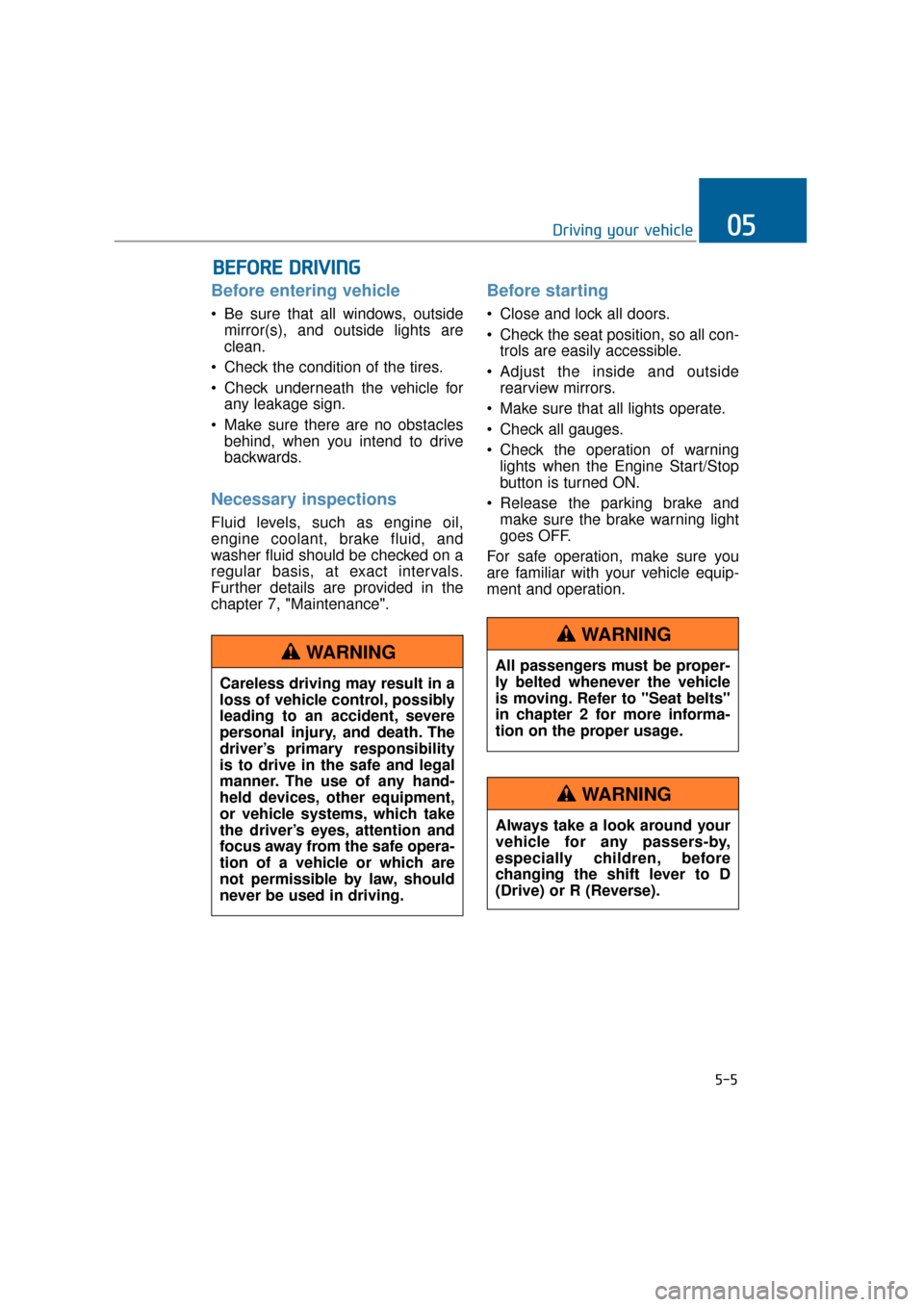
Before entering vehicle
• Be sure that all windows, outsidemirror(s), and outside lights are
clean.
Check the condition of the tires.
Check underneath the vehicle for any leakage sign.
Make sure there are no obstacles behind, when you intend to drive
backwards.
Necessary inspections
Fluid levels, such as engine oil,
engine coolant, brake fluid, and
washer fluid should be checked on a
regular basis, at exact intervals.
Further details are provided in the
chapter 7, "Maintenance".
Before starting
Close and lock all doors.
Check the seat position, so all con-trols are easily accessible.
Adjust the inside and outside rearview mirrors.
Make sure that all lights operate.
Check all gauges.
Check the operation of warning lights when the Engine Start/Stop
button is turned ON.
Release the parking brake and make sure the brake warning light
goes OFF.
For safe operation, make sure you
are familiar with your vehicle equip-
ment and operation.
B B E
EF
FO
O R
RE
E
D
D R
RI
IV
V I
IN
N G
G
5-5
Driving your vehicle05
Careless driving may result in a
loss of vehicle control, possibly
leading to an accident, severe
personal injury, and death. The
driver’s primary responsibility
is to drive in the safe and legal
manner. The use of any hand-
held devices, other equipment,
or vehicle systems, which take
the driver’s eyes, attention and
focus away from the safe opera-
tion of a vehicle or which are
not permissible by law, should
never be used in driving.
WARNINGAll passengers must be proper-
ly belted whenever the vehicle
is moving. Refer to "Seat belts"
in chapter 2 for more informa-
tion on the proper usage.
WARNING
Always take a look around your
vehicle for any passers-by,
especially children, before
changing the shift lever to D
(Drive) or R (Reverse).
WARNING
Page 325 of 477
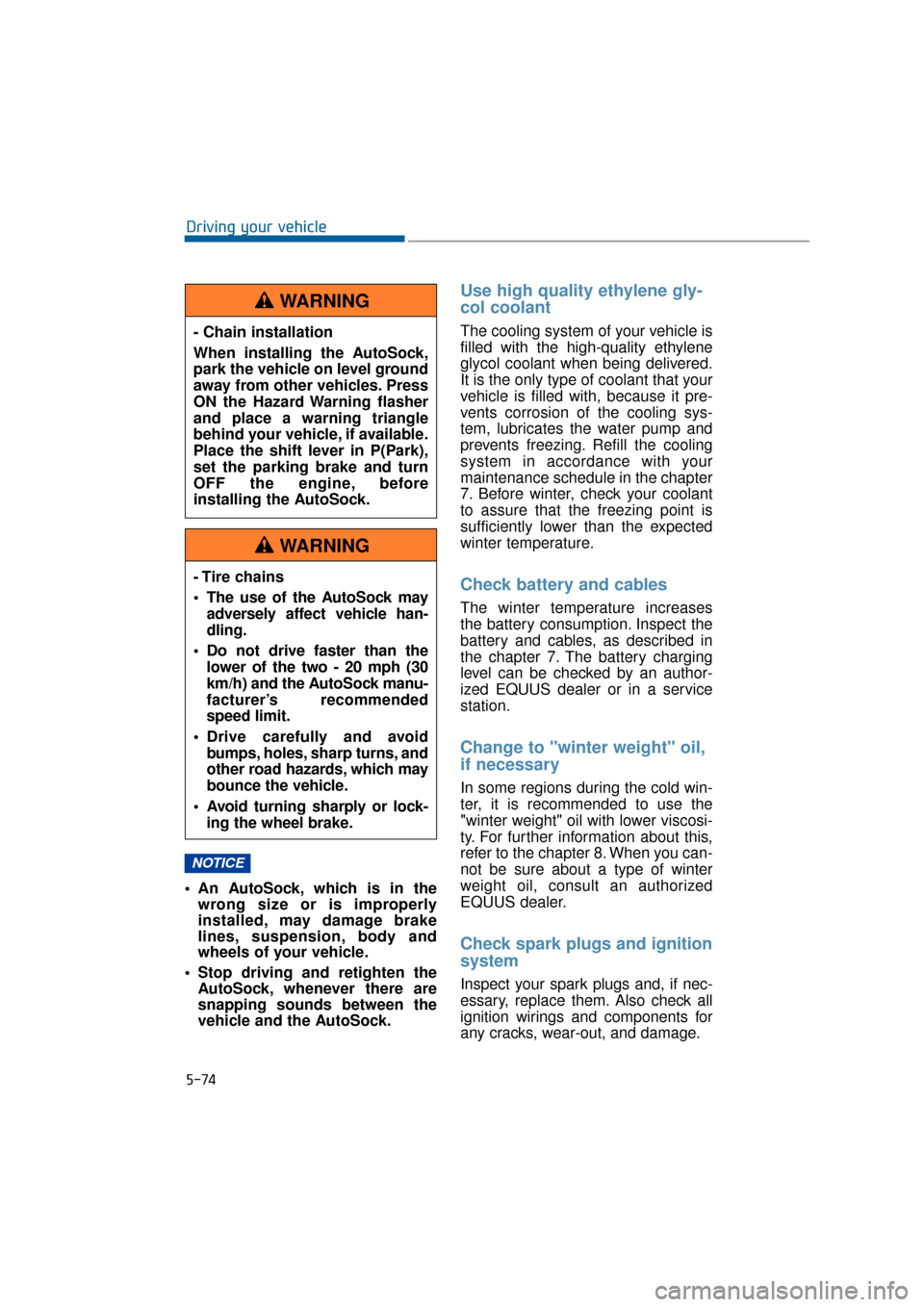
5-74
Driving your vehicle
An AutoSock, which is in the wrong size or is improperly
installed, may damage brake
lines, suspension, body and
wheels of your vehicle.
Stop driving and retighten the AutoSock, whenever there are
snapping sounds between the
vehicle and the AutoSock.
Use high quality ethylene gly-
col coolant
The cooling system of your vehicle is
filled with the high-quality ethylene
glycol coolant when being delivered.
It is the only type of coolant that your
vehicle is filled with, because it pre-
vents corrosion of the cooling sys-
tem, lubricates the water pump and
prevents freezing. Refill the cooling
system in accordance with your
maintenance schedule in the chapter
7. Before winter, check your coolant
to assure that the freezing point is
sufficiently lower than the expected
winter temperature.
Check battery and cables
The winter temperature increases
the battery consumption. Inspect the
battery and cables, as described in
the chapter 7. The battery charging
level can be checked by an author-
ized EQUUS dealer or in a service
station.
Change to "winter weight" oil,
if necessary
In some regions during the cold win-
ter, it is recommended to use the
"winter weight" oil with lower viscosi-
ty. For further information about this,
refer to the chapter 8. When you can-
not be sure about a type of winter
weight oil, consult an authorized
EQUUS dealer.
Check spark plugs and ignition
system
Inspect your spark plugs and, if nec-
essary, replace them. Also check all
ignition wirings and components for
any cracks, wear-out, and damage.
NOTICE
- Chain installation
When installing the AutoSock,
park the vehicle on level ground
away from other vehicles. Press
ON the Hazard Warning flasher
and place a warning triangle
behind your vehicle, if available.
Place the shift lever in P(Park),
set the parking brake and turn
OFF the engine, before
installing the AutoSock.
WARNING
- Tire chains
The use of the AutoSock may
adversely affect vehicle han-
dling.
Do not drive faster than the lower of the two - 20 mph (30
km/h) and the AutoSock manu-
facturer’s recommended
speed limit.
Drive carefully and avoid bumps, holes, sharp turns, and
other road hazards, which may
bounce the vehicle.
Avoid turning sharply or lock- ing the wheel brake.
WARNING
Page 339 of 477
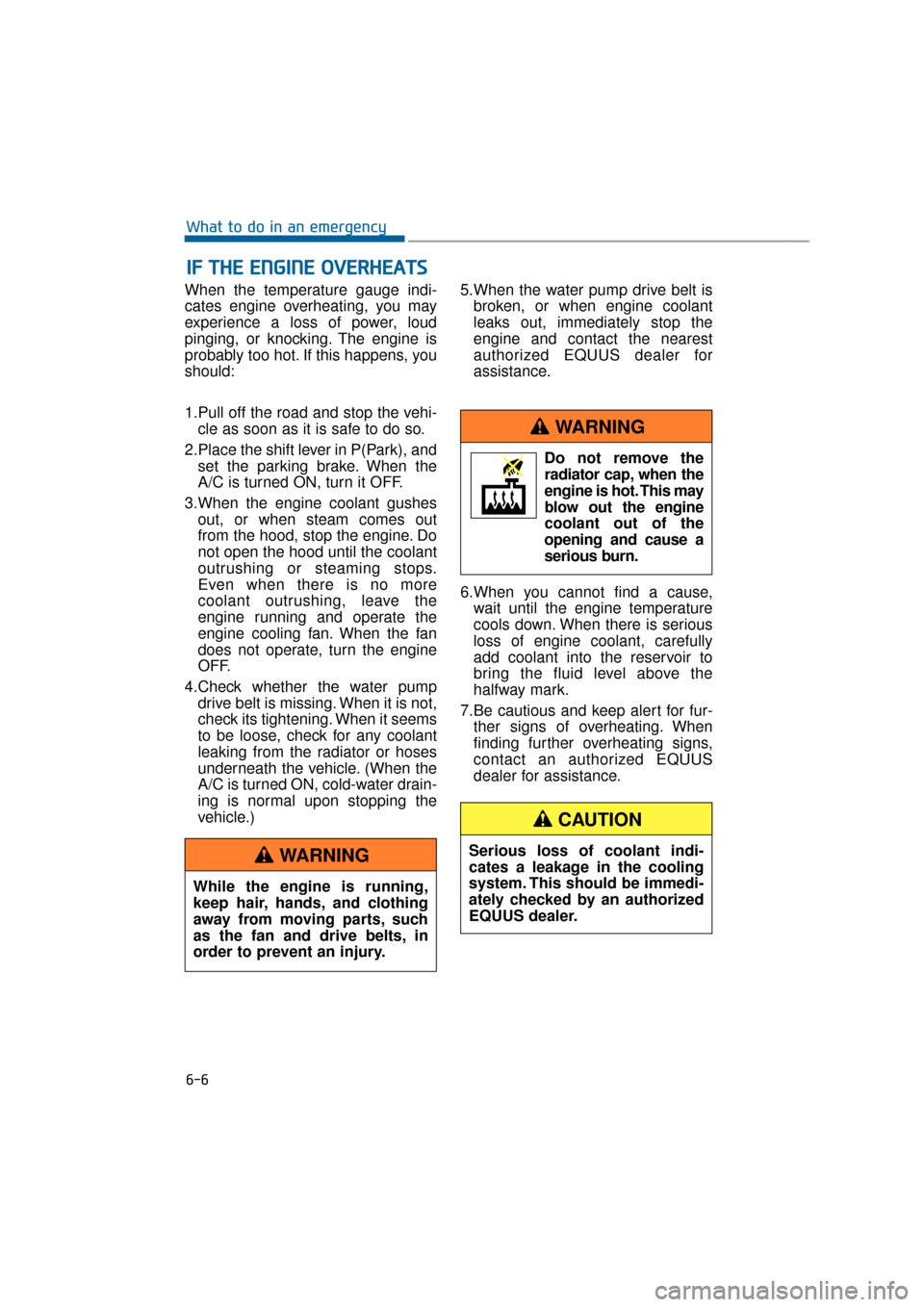
When the temperature gauge indi-
cates engine overheating, you may
experience a loss of power, loud
pinging, or knocking. The engine is
probably too hot. If this happens, you
should:
1.Pull off the road and stop the vehi-cle as soon as it is safe to do so.
2.Place the shift lever in P(Park), and set the parking brake. When the
A/C is turned ON, turn it OFF.
3.When the engine coolant gushes out, or when steam comes out
from the hood, stop the engine. Do
not open the hood until the coolant
outrushing or steaming stops.
Even when there is no more
coolant outrushing, leave the
engine running and operate the
engine cooling fan. When the fan
does not operate, turn the engine
OFF.
4.Check whether the water pump drive belt is missing. When it is not,
check its tightening. When it seems
to be loose, check for any coolant
leaking from the radiator or hoses
underneath the vehicle. (When the
A/C is turned ON, cold-water drain-
ing is normal upon stopping the
vehicle.) 5.When the water pump drive belt is
broken, or when engine coolant
leaks out, immediately stop the
engine and contact the nearest
authorized EQUUS dealer for
assistance.
6.When you cannot find a cause, wait until the engine temperature
cools down. When there is serious
loss of engine coolant, carefully
add coolant into the reservoir to
bring the fluid level above the
halfway mark.
7.Be cautious and keep alert for fur- ther signs of overheating. When
finding further overheating signs,
contact an authorized EQUUS
dealer for assistance.
I IF
F
T
T H
H E
E
E
E N
N G
GI
IN
N E
E
O
O V
VE
ER
R H
H E
EA
A T
TS
S
6-6
What to do in an emergency
While the engine is running,
keep hair, hands, and clothing
away from moving parts, such
as the fan and drive belts, in
order to prevent an injury.
WARNING
Do not remove theradiator cap, when the
engine is hot. This may
blow out the engine
coolant out of the
opening and cause a
serious burn.
WARNING
Serious loss of coolant indi-
cates a leakage in the cooling
system. This should be immedi-
ately checked by an authorized
EQUUS dealer.
CAUTION
Page 358 of 477

Maintenance
Engine compartment .............................................7-4
Maintenance services ...........................................7-5
Owner's responsibility ......................................................7-5
Owner's maintenance precautions ...............................7-6
Owner's maintenance ...........................................7-7
Owner's maintenance schedule ....................................7-7
Scheduled maintenance service ..........................7-8
Normal maintenance schedule .......................................7-9
Maintenance under severe usage conditions ..........7-22
Explanation of scheduled maintenance
items.......................................................................7\
-23
Engine oil ..............................................................7-25
Checking the engine oil level ....................................7-25
Changing the engine oil and filter ..............................7-26
Engine coolant......................................................7-27
Checking the coolant level ...........................................7-27
Changing the coolant .....................................................7-29
Brake fluid ............................................................7-30
Checking the brake fluid level .....................................7-30
Power steering fluid ............................................7-31
Checking the power steering fluid level ...................7-31
Checking the power steering hose.............................7-31
Washer fluid .........................................................7-32
Checking the washer fluid level ..................................7-32
Air cleaner ............................................................7-33
Filter replacement ...........................................................7-33
Page 364 of 477
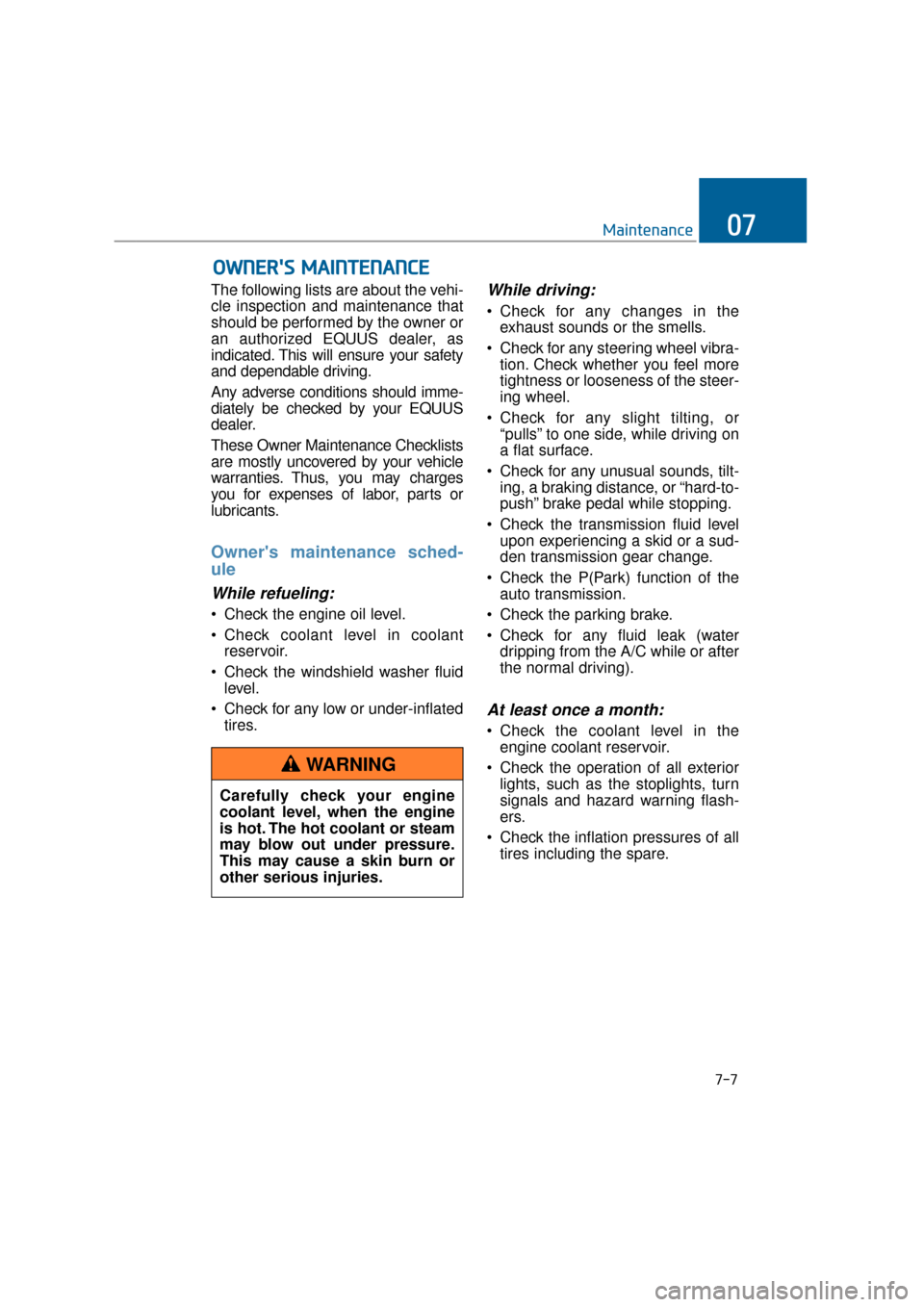
The following lists are about the vehi-
cle inspection and maintenance that
should be performed by the owner or
an authorized EQUUS dealer, as
indicated. This will ensure your safety
and dependable driving.
Any adverse conditions should imme-
diately be checked by your EQUUS
dealer.
These Owner Maintenance Checklists
are mostly uncovered by your vehicle
warranties. Thus, you may charges
you for expenses of labor, parts or
lubricants.
Owner's maintenance sched-
ule
While refueling:
Check the engine oil level.
Check coolant level in coolantreservoir.
Check the windshield washer fluid level.
Check for any low or under-inflated tires.
While driving:
Check for any changes in theexhaust sounds or the smells.
Check for any steering wheel vibra- tion. Check whether you feel more
tightness or looseness of the steer-
ing wheel.
Check for any slight tilting, or “pulls” to one side, while driving on
a flat surface.
Check for any unusual sounds, tilt- ing, a braking distance, or “hard-to-
push” brake pedal while stopping.
Check the transmission fluid level upon experiencing a skid or a sud-
den transmission gear change.
Check the P(Park) function of the auto transmission.
Check the parking brake.
Check for any fluid leak (water dripping from the A/C while or after
the normal driving).
At least once a month:
Check the coolant level in theengine coolant reservoir.
Check the operation of all exterior lights, such as the stoplights, turn
signals and hazard warning flash-
ers.
Check the inflation pressures of all tires including the spare.
O OW
W N
NE
ER
R '
'S
S
M
M A
AI
IN
N T
TE
EN
N A
AN
N C
CE
E
7-7
Maintenance07
Carefully check your engine
coolant level, when the engine
is hot. The hot coolant or steam
may blow out under pressure.
This may cause a skin burn or
other serious injuries.
WARNING
Page 384 of 477
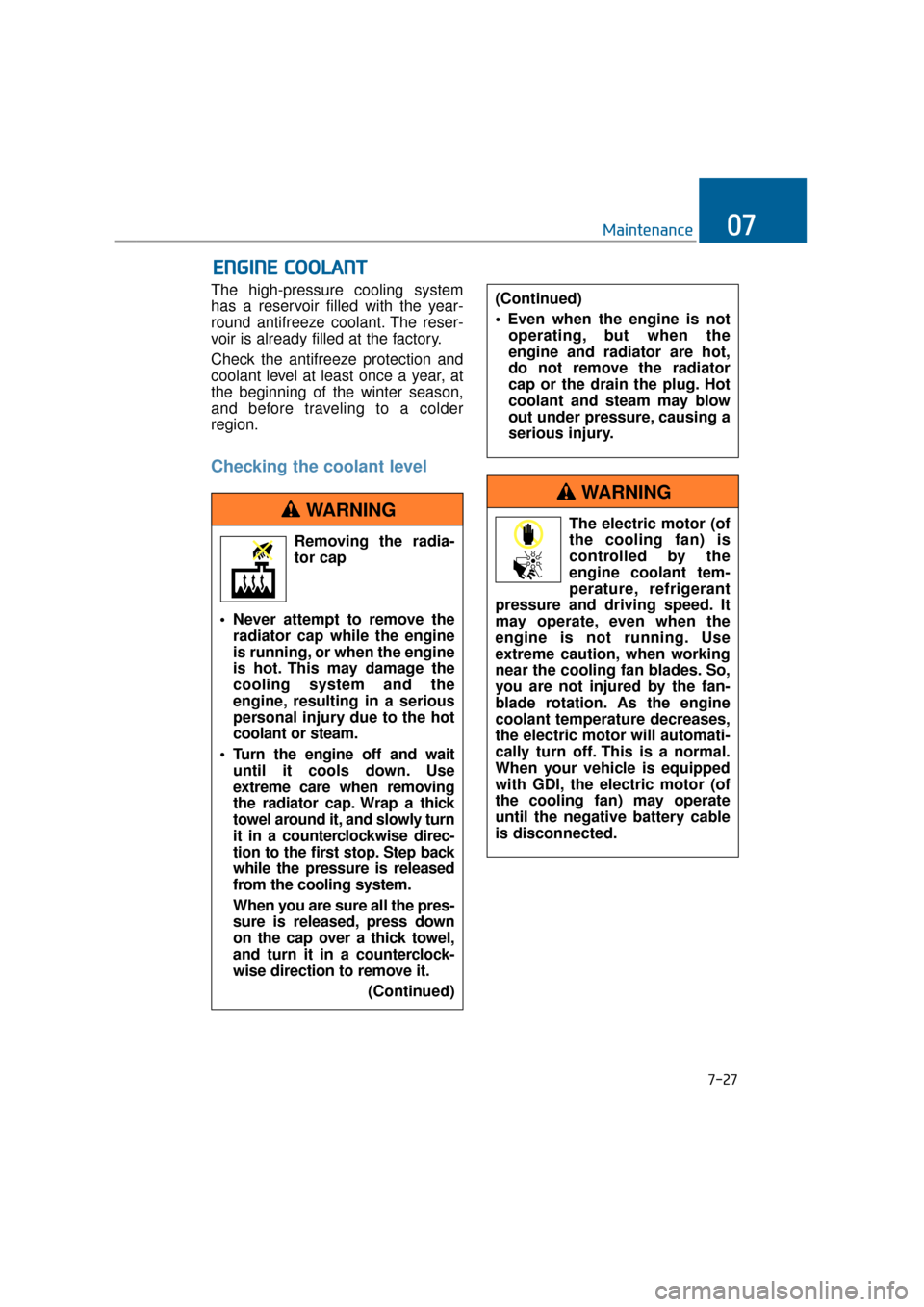
7-27
Maintenance07
The high-pressure cooling system
has a reservoir filled with the year-
round antifreeze coolant. The reser-
voir is already filled at the factory.
Check the antifreeze protection and
coolant level at least once a year, at
the beginning of the winter season,
and before traveling to a colder
region.
Checking the coolant level
E EN
N G
GI
IN
N E
E
C
C O
O O
OL
LA
A N
N T
T
(Continued)
operating, but when the
engine and radiator are hot,
do not remove the radiator
cap or the drain the plug. Hot
coolant and steam may blow
out under pressure, causing a
serious injury.
The electric motor (of
the cooling fan) is
controlled by the
engine coolant tem-
perature, refrigerant
pressure and driving speed. It
may operate, even when the
engine is not running. Use
extreme caution, when working
near the cooling fan blades. So,
you are not injured by the fan-
blade rotation. As the engine
coolant temperature decreases,
the electric motor will automati-
cally turn off. This is a normal.
When your vehicle is equipped
with GDI, the electric motor (of
the cooling fan) may operate
until the negative battery cable
is disconnected.
WARNING
Removing the radia-
tor cap
Never attempt to remove the radiator cap while the engine
is running, or when the engine
is hot. This may damage the
cooling system and the
engine, resulting in a serious
personal injury due to the hot
coolant or steam.
Turn the engine off and wait until it cools down. Use
extreme care when removing
the radiator cap. Wrap a thick
towel around it, and slowly turn
it in a counterclockwise direc-
tion to the first stop. Step back
while the pressure is released
from the cooling system.
When you are sure all the pres-
sure is released, press down
on the cap over a thick towel,
and turn it in a counterclock-
wise direction to remove it.
(Continued)
WARNING
Page 385 of 477
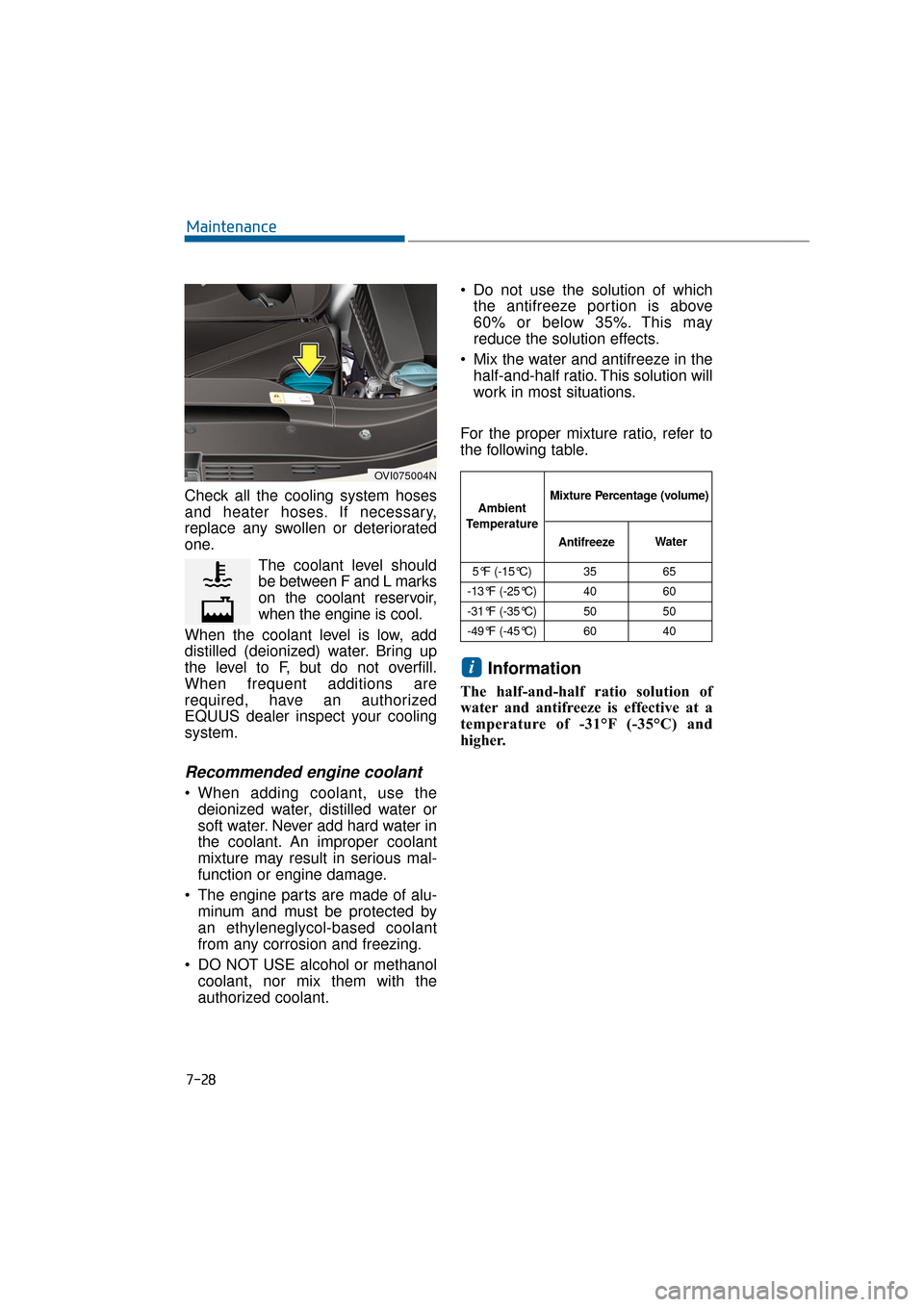
7-28
Maintenance
Check all the cooling system hoses
and heater hoses. If necessary,
replace any swollen or deteriorated
one. The coolant level should
be between F and L marks
on the coolant reservoir,
when the engine is cool.
When the coolant level is low, add
distilled (deionized) water. Bring up
the level to F, but do not overfill.
When frequent additions are
required, have an authorized
EQUUS dealer inspect your cooling
system.
Recommended engine coolant
When adding coolant, use the deionized water, distilled water or
soft water. Never add hard water in
the coolant. An improper coolant
mixture may result in serious mal-
function or engine damage.
The engine parts are made of alu- minum and must be protected by
an ethyleneglycol-based coolant
from any corrosion and freezing.
DO NOT USE alcohol or methanol coolant, nor mix them with the
authorized coolant. Do not use the solution of which
the antifreeze portion is above
60% or below 35%. This may
reduce the solution effects.
Mix the water and antifreeze in the half-and-half ratio. This solution will
work in most situations.
For the proper mixture ratio, refer to
the following table.
Information
The half-and-half ratio solution of
water and antifreeze is effective at a
temperature of -31°F (-35°C) and
higher.
i
OVI075004N
5°F (-15°C) 35 65
-13°F (-25°C) 40 60
-31°F (-35°C) 50 50
-49°F (-45°C) 60 40
Ambient
Temperature Mixture Percentage (volume)
Antifreeze Water
Page 389 of 477
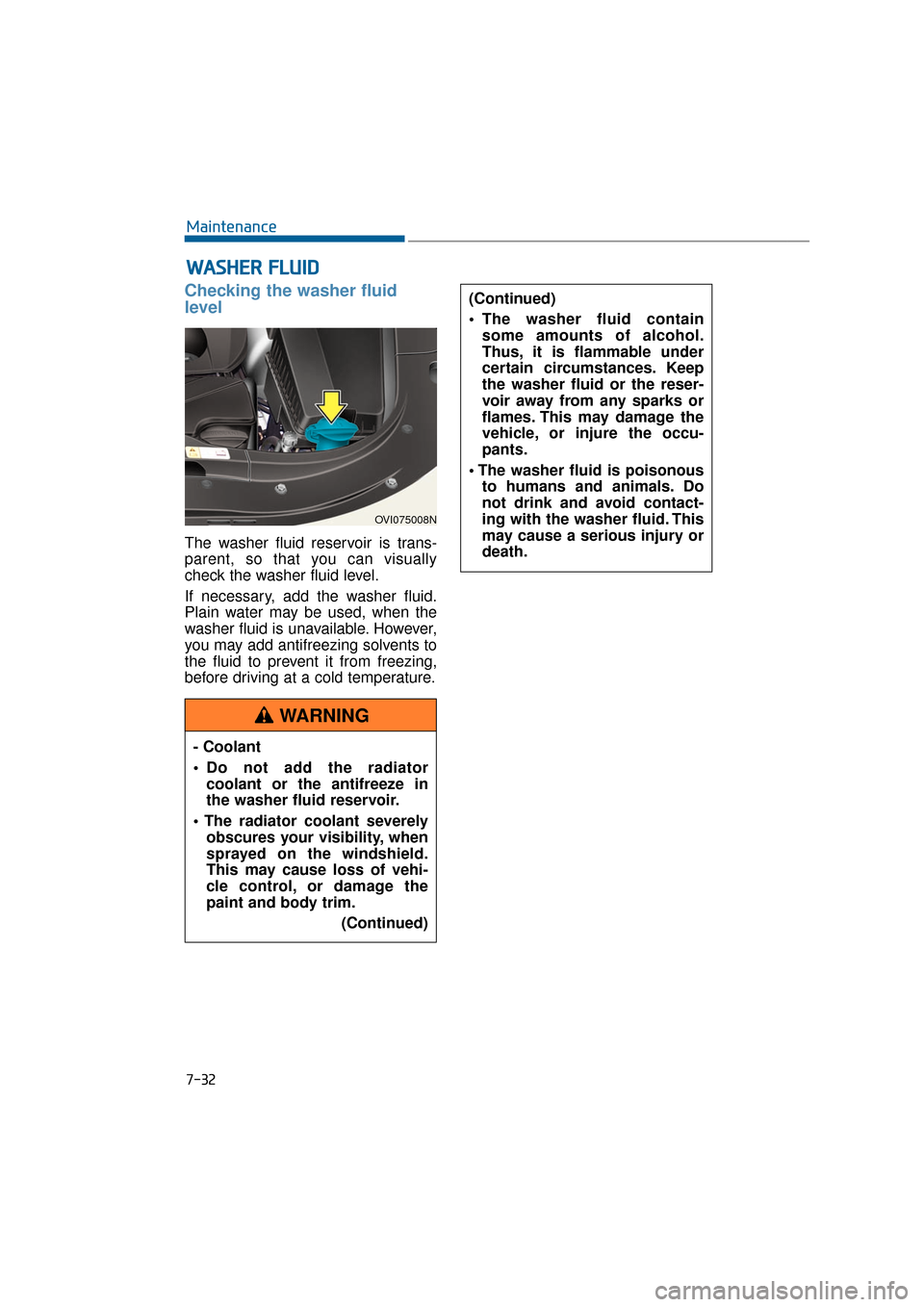
7-32
Maintenance
Checking the washer fluid
level
The washer fluid reservoir is trans-
parent, so that you can visually
check the washer fluid level.
If necessary, add the washer fluid.
Plain water may be used, when the
washer fluid is unavailable. However,
you may add antifreezing solvents to
the fluid to prevent it from freezing,
before driving at a cold temperature.
W WA
AS
SH
H E
ER
R
F
F L
LU
U I
ID
D
OVI075008N
- Coolant
Do not add the radiator
coolant or the antifreeze in
the washer fluid reservoir.
obscures your visibility, when
sprayed on the windshield.
This may cause loss of vehi-
cle control, or damage the
paint and body trim.
(Continued)
(Continued)
The washer fluid containsome amounts of alcohol.
Thus, it is flammable under
certain circumstances. Keep
the washer fluid or the reser-
voir away from any sparks or
flames. This may damage the
vehicle, or injure the occu-
pants.
to humans and animals. Do
not drink and avoid contact-
ing with the washer fluid. This
may cause a serious injury or
death.
WARNING